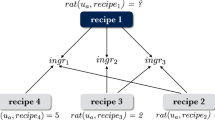Abstract
The mobile Internet introduces new opportunities to gain insight in the user’s environment, behavior, and activity. This contextual information can be used as an additional information source to improve traditional recommendation algorithms. This paper describes a framework to detect the current context and activity of the user by analyzing data retrieved from different sensors available on mobile devices. The framework can easily be extended to detect custom activities and is built in a generic way to ensure easy integration with other applications. On top of this framework, a recommender system is built to provide users a personalized content offer, consisting of relevant information such as points-of-interest, train schedules, and touristic info, based on the user’s current context. An evaluation of the recommender system and the underlying context recognition framework shows that power consumption and data traffic is still within an acceptable range. Users who tested the recommender system via the mobile application confirmed the usability and liked to use it. The recommendations are assessed as effective and help them to discover new places and interesting information.




Similar content being viewed by others
References
Adomavicius G, Sankaranarayanan R, Sen S, Tuzhilin A (2005) Incorporating contextual information in recommender systems using a multidimensional approach. ACM Trans Inf Syst 23(1):103–145
Antoniou J, Pinto F, Simoes J, Pitsillides A (2010) Supporting context-aware multiparty sessions in heterogeneous mobile networks. Mobile Netw Appl 15:831–844
Bao L, Intille S (2004) Activity recognition from user-annotated acceleration data. In: Ferscha A, Mattern F (eds) Pervasive computing. Lecture notes in computer science, vol 3001. Springer Berlin / Heidelberg, pp 1–17
Biegel G, Cahill V (2004) A framework for developing mobile, context-aware applications. In: Proceedings of the second IEEE international conference on pervasive computing and communications (PerCom’04), PERCOM ’04. IEEE Computer Society, Washington, DC, USA, pp 361–365
Breese JS, Heckerman D, Kadie C (1998) Empirical analysis of predictive algorithms for collaborative filtering. In: Proceedings of the fourteenth conference on uncertainty in artificial intelligence, UAI’98. Morgan Kaufmann Publishers Inc., San Francisco, CA, USA, pp 43–52
Brown P, Bovey J, Chen X (1997) Context-aware applications: from the laboratory to the marketplace. IEEE Personal Communications 4(5):58–64
CultuurNet-Vlaanderen (2012) Uitdatabank developer tools. Available at http://tools.uitdatabank.be/docs. Accessed 15 Sept 2012
Debaty P, Goddi P, Vorbau A (2005) Integrating the physical world with the web to enable context-enhanced mobile services. Mobile Networks and Applications 10(4):385–394
Dey AK (2001) Understanding and using context. Personal and Ubiquitous Computing 5(1):4–7
Dodson B (2012) Wikilocation. Available at http://wikilocation.org/. Accessed 1 Oct 2012
Foursquare (2012) Foursquare API. Available at https://developer.foursquare.com/. Accessed 1 Oct 2012
Gellersen H, Schmidt A, Beigl M (2002) Multi-sensor context-awareness in mobile devices and smart artifacts. Mobile Netw Appl 7:341–351
Google (2012) Geocoding API. Available at https://developers.google.com/maps/documentation/geocoding/. Accessed 1 Oct 2012
Google (2012) Places API. Available at https://developers.google.com/places/documentation/. Accessed 1 Oct 2012
Han BJ, Rho S, Jun S, Hwang E (2010) Music emotion classification and context-based music recommendation. Multimedia Tools Appl 47(3):433–460
Herlocker JL, Konstan JA, Terveen LG, Riedl JT (2004) Evaluating collaborative filtering recommender systems. ACM Trans Inf Syst 22(1):5–53
HLN (2012) Rss news feed. Available at http://www.hln.be/rss.xml. Accessed 15 Nov 2012
Iacono M, Krizek K, El-Geneidy A (2008) Access to destinations: how close is close enough? estimating accurate distance decay functions for multiple modes and different purposes. Tech. rep., University of Minnesota, Twin Cities. Minnesota Department of Transportation, Ref.: MN/RC 2008-11
Inc S (2012) Humidity and Temperature Sensor for Mobile Devices. Available at http://news.thomasnet.com/companystory/Humidity-and-Temperature-Sensor-for-Mobile-Devices-851215
Kenteris M, Gavalas D, Mpitziopoulos A (2010) A mobile tourism recommender system. In: Proceedings of the IEEE symposium on computers and communications, ISCC ’10. IEEE Computer Society, Washington, DC, USA, pp 840–845
Kwapisz JR, Weiss GM, Moore SA (2011) Activity recognition using cell phone accelerometers. SIGKDD Explor Newsl 12(2):74–82
Lee Mh, Kim J, Kim K, Lee I, Jee SH, Yoo SK (2009) Physical activity recognition using a single tri-axis accelerometer. In: Proceedings of the world congress on engineering and computer science, vol 1
Lee SW, Mase K (2002) Activity and location recognition using wearable sensors. IEEE Pervasive Computing 1(3):24–32
Oh JM, Moon N (2012) User-selectable interactive recommendation system in mobile environment. Multimed Tools Appl 57:295–313
Oku K, Nakajima S, Miyazaki J, Uemura S (2006) Context-aware svm for context-dependent information recommendation. In: 7th international conference on mobile data management, 2006. MDM 2006. pp 109–109
Ravi N, Dandekar N, Mysore P, Littman ML (2005) Activity recognition from accelerometer data. In: Proceedings of the 17th conference on Innovative applications of artificial intelligence, vol 3, IAAI’05. AAAI Press, pp 1541–1546
Ricci F (2010) Mobile recommender systems. Information Technology & Tourism (ITT) 12(3), 205–231
Schilit B, Theimer M (1994) Disseminating active map information to mobile hosts. IEEE Netw 8(5):22–32
Schiller J, Voisard A (2004) Location-based services. Morgan Kaufmann
Tiete Y, Schmitz S, Colpaert P iRail API (2012). Available at http://project.irail.be/wiki/API/APIv1. Accessed 8 Nov 2012
Wagner J, Geleijnse G, van Halteren A (2011) Guidance and support for healthy food preparation in an augmented kitchen. In: Proceedings of the 2011 workshop on context-awareness in retrieval and recommendation, CaRR ’11. ACM, New York, NY, USA, pp 47–50
Acknowledgements
The authors would like to thank Bart Matté and Ewout Meyns for their programming work in this research project.
Author information
Authors and Affiliations
Corresponding author
Rights and permissions
About this article
Cite this article
De Pessemier, T., Dooms, S. & Martens, L. Context-aware recommendations through context and activity recognition in a mobile environment. Multimed Tools Appl 72, 2925–2948 (2014). https://doi.org/10.1007/s11042-013-1582-x
Published:
Issue Date:
DOI: https://doi.org/10.1007/s11042-013-1582-x




